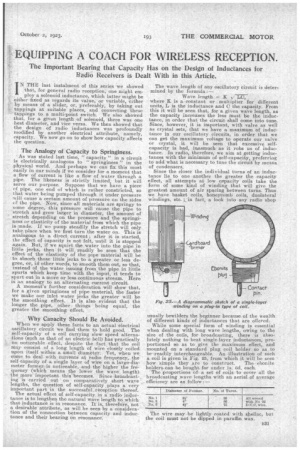EQUIPPING A COACH FOR WIRELESS RECEPTION.
Page 17

If you've noticed an error in this article please click here to report it so we can fix it.
The Important Bearing that Capacity Has on the Design of Inductances for Radio Receivers is Dealt With in this Article.
I ' N THE last instalment of this series we showed that, for general radio reception, one might em ploy a solenoid inductance, which latter might be either fixed as regards its v'a.lue,r or variable, either by means of a slider, or, preferably, by taking out tappings at suitable places, and connecting these tappings to a multi-point switch. We also showed that, for a given length of solenoid, there was one best diameter, and vice versa. We then showed that the design of radio inductances was profoundly modified by another electrical attribute, namely, capacity. We now go on to show how capacity affects the question.
The Analogy of Capacity to Springiness.
As was stated last time, " capacity " in a circuit is electrically analogous to " springiness " in the .physical world. And perhaps we can fix this most easily in our minds if we consider for a Moment that a flow of current is like a flow of water through a pipe. The likeness is strictly limited, but it will serve our purpose. Suppose that we have a piece of pipe, one end of which is rather constricted, so that water being pumped through it under pressure will cause a certain amount of pressure on the sides of the pipe. Now, since all materials are springy to some degree, this pressure will cause the pipe to stretch and grow larger in diameter, the amount of stretch depending on the pressure and the springiness or elasticity of the material from which the pipe is made. If we pump steadily the stretch will only fake place when we first turn the water on. This is analogous to a direct current ; after it is started, the effect of capacity is not felt, until it is stopped again. But, if we squirt the water into the pipe in little jerks, then it will readily be seen that the effect of the elasticity of the pipe material will be to absorb those little jerks to a greater, or less degree, or, in other words, to smooth them out, so that, instead of the water issuing from the pipe in little spurts which keep time with the input, it tends to spurt out in a more or less continuous stream. Here is an analogy to an alternating current. circuit. A moment's further consideration will show that, for a given springiness of pipe material, the faster we make our inlet water jerks the greater will be the smoothing effect. It is also evident that the longer the pipe, other things being equal, the greater the smoothing effect.
Why Capacity Should Be Avoided.
When we apply these facts to an actual electrical oscillatory circuit we find them to hold good. The self-capacity of a coil carrying slow speed alternations (such as that of an electric bell) has practically no noticeable effect, despite the fact that the coil may consist of a long length of wire 'closely coiled upon itself within a small diameter. Yet, when we come to deal with currents at radio frequency, the self-capacity of al single layer of wire on a large-diameter former, is noticeable, and the higher the frequency (which means the lower the wave length) the more important this becomes. Since broadcasting is carried out on comparatively short wave lengths, the question of self-capacity plays a very important part in the successful reception thereof.
The actual effect of self-capacity, in a radio inductance is to lengthen the natural wave length to which that inductance is in resonance. It is, therefore, not a desirable attribute, as will be seen by a consideration of the connection between capacity and inductance and their bearing on resonance.
The wave length of any oscillatory circuit is determined by the formula :— Wave length = K LO, where K is a constant or multiplier for different units, L is the inductance and C the capacity. From this it will be seen that, for a given wave length, as the capacity increases the less must be the inductance, in order that the circuit shall come into tune. Since, however; it is important, with valve as well as crystal sets, that we have a maximum of inductance in our oscillatory circuits, in order that we can get the maximum voltage to operate our valve or crystal, it will be seen that excessive selfcapacity is bad, in.asmuch as it robs us of inductance. In radio, therefore, we aim at getting inductances with the minimum of self-capacity, preferring to add what is necessary to tune the circuit by means of condensers.
Since the closer the individual turns of an inductance lie to one another the greater the capacity effect, all attempts at low capacity coils take the form of some kind of winding that will give the greatest amount of air spacing between turns. Thus we have basket coils, honeycomb coils, duolateral windings, etc. in fact, a look into any radio shop usually bewilders the beginner because. of the wealth of different kinds of inductances that are offered.
While some special form of winding is essential when dealing with long wave lengths, owing to the size of the coils, for broadcasting, there is absolutely nothing to beat single-layer inductances, proportioned 90 as to give the maximum effect, and mounted on a standard plug coil holder so as to be readily interchangeable. An illustration of such a coil is given in Fig. 25, from which it will be seen
how Simple they are to construct. The ebonite holders can be bought for under is. 6d. each. The proportions of a set of coils to cover all the broadcasting wave lengths with an aerial of average efficiency are as follow :"—
































